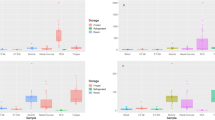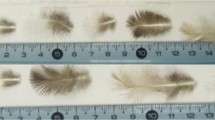Abstract
Genetic analyses have become increasingly important in animal wildlife research where they have provided information of direct relevance to species and population management. An integral part of genetic analysis is the isolation of PCR-amplifiable DNA. However, addressing the issue of DNA isolation in animal wildlife research can be challenging due to the wide range of potential biological sources used to obtain DNA. Here, we present a modified silica-based DNA isolation method for obtaining PCR-amplifiable DNA from a wide range of biological sources typically encountered in animal wildlife research. We compared the present method with commonly used non-commercial and commercially available DNA extraction methods. Our results show that DNA yield, quality and purity (as assessed by PCR amplification) are qualitatively comparable, and in many cases even better, than commonly used non-commercial and commercially available DNA extraction methods. We describe the main factors that can affect DNA yield and provide variants of the basic protocol that can be performed according to the DNA source. The simplicity, versatility and cost-effectiveness of this method, as well as the absence of hazardous reagents, makes it a valuable addition to the molecular toolbox of any wildlife genetics laboratory.

Similar content being viewed by others
References
Boom R, Sol CJ, Salimans MM, Jansen CL, Wertheim-Van Dillen PM, Van Der Noordaa J (1990) Rapid and simple method for purification of nucleic acids. J Clin Microbiol 28(3):495–503
Bouwman AS, Brown TA (2002) Comparison between silica-based methods for the extraction of DNA from human bones from 18th to mid-19th century London. Anc Biomol 4(4):173–178
Carter MJ, Milton ID (1993) An inexpensive and simple method for DNA purifications on silica particles. Nucleic Acids Res 21(4):1044
Collins AC, Dubach JM (2000) Phylogenetic relationships of spider monkeys (Ateles) based on mitochondrial DNA variation. Int J Primatol 21(3):381–420
Dabney J, Knapp M, Glocke I, Gansauge MT, Weihmann A, Nickel B, Valdiosera C, Garcia N (2013) Complete mitochondrial genome sequence of a Middle Pleistocene cave bear reconstructed from ultrashort DNA fragments. Proc Natl Acad Sci USA 110(39):15758–15763
DeSalle R, Amato G (2004) The expansion of conservation genetics. Nat Rev Genet 5(9):702–712
DeWoody JA (2005) Molecular approaches to the study of parentage, relatedness, and fitness: practical applications for wild animals. J Wildl Manage 69(4):1400–1418
DeYoung RW, Brennan LA (2005) Molecular genetics in wildlife science, conservation, and management. J Wildl Manage 69(4):1360–1361
DeYoung RW, Honeycutt RL (2005) The Molecular toolbox: genetic techniques in wildlife ecology and management. J Wildl Manage 69(4):1362–1384
Dreher BP, Winterstein SR, Scribner KT, Lukacs PM, Etter DR, Rosa GJM, Lopez VA, Libants S, Filcek KB (2007) Noninvasive estimation of black bear abundance incorporating genotyping errors and harvested bear. J Wildl Manage 71(8):2684–2693
Faivovich J, Haddad CF, Garcia PCA, Frost DR, Campbell JA, Wheeler WC (2005) Systematic review of the frog family Hylidae, with special reference to Hylinae: phylogenetic analysis and taxonomic revision. Bull Am Mus Nat Hist 294:1–240
Gonçalves De Andrade FA, Barroncas Fernandes ME, Barros MC, Schneider H (2006) A range extension for the yellow armadillo, Euphractus sexcinctus Linnaeus, 1758 (Xenarthra: DASYPODIDAE), in the Eastern Brazilian Amazon. Edentata 7:25–30
Greenspoon SA, Scarpetta MA, Drayton ML, Turek SA (1998) QIAamp spin columns as a method of DNA isolation from forensic casework. J Forensic Sci 43:1024–1030
Hillis DM, Mable BK, Larson A, Davis SK, Zimmer EA (1996) Nucleic acids IV: sequencing and cloning. In: Hillis DM, Moritz C, Mable BK (eds) Molecular systematics, Sinauer, Sunderland, pp. 321–381
Hwan-Young L, Myung JP, Young-Kim NA, Jeong, S, Woo-Ick Y, Kyoung-Jin S (2010) A simple and highly effective DNA extraction methods from old skeletal remains using silica columns. Forensic Sci Int 5(4):275–280
Kendall KC, Stetz JB, Roon DA, Waits LP, Boulanger JB, Paetkau D (2008) Grizzly bear density in Glacier National Park, Montana. J Wildl Manage 72(8):1693–1705
Lukacs PM, Burnham KP (2005) Estimating population size from DNA-based closed capture-recapture data incorporating genotyping error. J Wildl Manage 69(1):396–403
Melzak KA, Sherwood CS, Turner RFB, Haynes CA (1996) Driving forces for DNA adsorption to silica in perchlorate solutions. J Colloid Interface Sci 181:635–644
Merante F, Raha S, Reed JK, Proteau G (1996) The simultaneous isolation of RNA and DNA from tissues and cultured cells. In: Harwood A (ed) Methods in molecular biology, basic DNA and RNA protocols, vol 58. Humana Press Inc, Totowa
Parida SK, Sukalyan D, Sabita P, Mishra BK (2006) Adsorption of organic molecules on silica surface. Adv Colloid Interface Sci 121:77–110
Pertoldi C, Breyne P, Cabria MT, Halfmaerten D, Jansman K (2006) Genetic structure of the European polecat (Mustela putorius) and its implication for conservation strategies. J Zool 270:102–115
Poeckh T, Lopez S, Fuller AO, Solomon MJ, Larson RG (2008) Adsorption and elution characteristics of nucleic acids on silica surfaces and their use in designing a miniaturized purification unit. Anal Biochem 373:253–262
QIAGEN (2001) Genomic DNA handbook for blood cultured cells tissue mouse tails yeast bacteria (Gram-negative and some Gram-positive)
QIAGEN (2008) MiniElute handbook
Radheshyam M, Brijesh K, Shyam S (2013) Evaluation of salt-out method for the isolation of DNA from whole blood: a pathological approach of DNA based diagnosis. IJLBPR 2(2):57–62
Reeves RG, Bermingham E (2006) Colonization, population expansion, and lineage turnover: phylogeography of mesoamerican characiform fish. Biol J Linn Soc 88:235–255
Riera MA, Rojas ME, Zapata PD (2010) Protocolo de extracción de DNA por salting-out para pequeños volúmenes de sangre. Rev Cienc Technol 14:4–7
Rohland N, Hofreiter M (2007a) Ancient DNA extraction from bones and teeth. Nat Protoc 2(7):1756–1762
Rohland N, Hofreiter M (2007b) Comparison and optimization of ancient DNA extraction. Biotechniques 42:343–352
Rohland N, Siedel H, Hofreiter M (2004) Nondestructive DNA extraction method for mitochondrial DNA analyses of museum specimens. Biotechniques 36:814–821
Rohland N, Siedel H, Hofreiter M (2010) A rapid column-based ancient DNA extraction method for increased sample throughput. Mol Ecol Resour 10(4):677–683
Sambrook J, Fritsch EF, Maniatis T (1989) Molecular cloning: a laboratory manual. Cold Spring Harbor Laboratory, New York, p 1626
Scribner KT, Blanchong JA, Bruggeman DJ, Epperson BK, Lee CY, Pan YW, Shorey RI, Prince HH, Winterstein SR, Luukkonen DR (2005) Geographical genetics: conceptual foundations and empirical applications of spatial genetic data in wildlife management. J Wildl Manage 69(4):1434–1453
Solari S (2010) A molecular perspective on the diversification of short-tailed opossums (Monodelphis: DIDELPHIDAE). Mastozool Neotropical 17(2):317–333
Solari S, Hoofer SR, Larsen PA, Brown AD, Bull RJ, Guerrero JA, Ortega J, Carrera JP, Bradley RD, Baker RJ (2009) Operational criteria for genetically defined species: analysis of the diversification of the small fruit-eating bats, Dermanura (PHYLLOSTOMIDAE: Stenodermatinae). Acta Chiropterologica 11(2):279–288
Vogelstein B, Gillespie D (1979) Preparative and analytical purification of DNA from agarose. Proc Natl Acad Sci USA 76(2):615–619
Waits LP, Paetkau D (2005) Noninvasive genetic sampling tools for wildlife biologists: a review of applications and recommendations for accurate data collection. J Wildl Manage 69(4):1419–1433
Acknowledgements
We thank researchers from the Biodiversity and Genetic Resources Research Group (Grupo de Biodiversidad y Recursos Genéticos), Instituto de Genética, Universidad Nacional de Colombia, for providing the biological material for this study. This work was carried out under the permit: Resolución 0255 de 2014 Autoridad Nacional de Licencias Ambientales (ANLA), Permiso Marco de Recolección de Especímenes de Especies Silvestres de la Diversidad Biológica con Fines de Investigación Científica No Comercial given to the Universidad Nacional de Colombia. Many people have provided invaluable comments that have helped improve this method. Special thanks go to Adriana Restrepo, Sebastián Arciniegas, Thomas Viloria, Diana Villamizar and Carolina Ibáñez. We would also like to thank Dr. Pedro Brandao, Department of Chemistry, Universidad Nacional de Colombia, and Sergio Pardo, CORPOICA, for providing bacteria cultures. We thank one anonymous reviewer for comments on an earlier version of the manuscript.
Author information
Authors and Affiliations
Corresponding author
Rights and permissions
About this article
Cite this article
Hoyos, M., Tusso, S., Bedoya, T.R. et al. A simple and cost-effective method for obtaining DNA from a wide range of animal wildlife samples. Conservation Genet Resour 9, 513–521 (2017). https://doi.org/10.1007/s12686-017-0735-z
Received:
Accepted:
Published:
Issue Date:
DOI: https://doi.org/10.1007/s12686-017-0735-z




